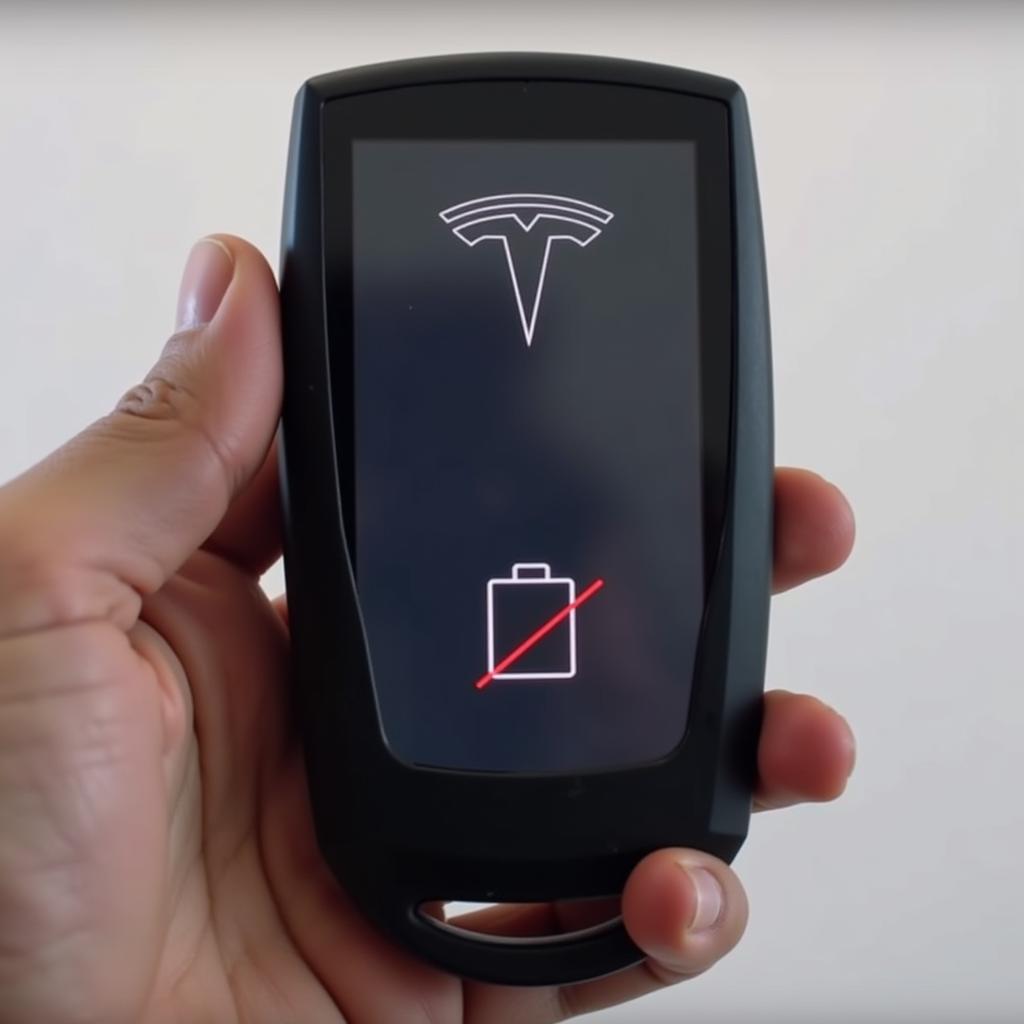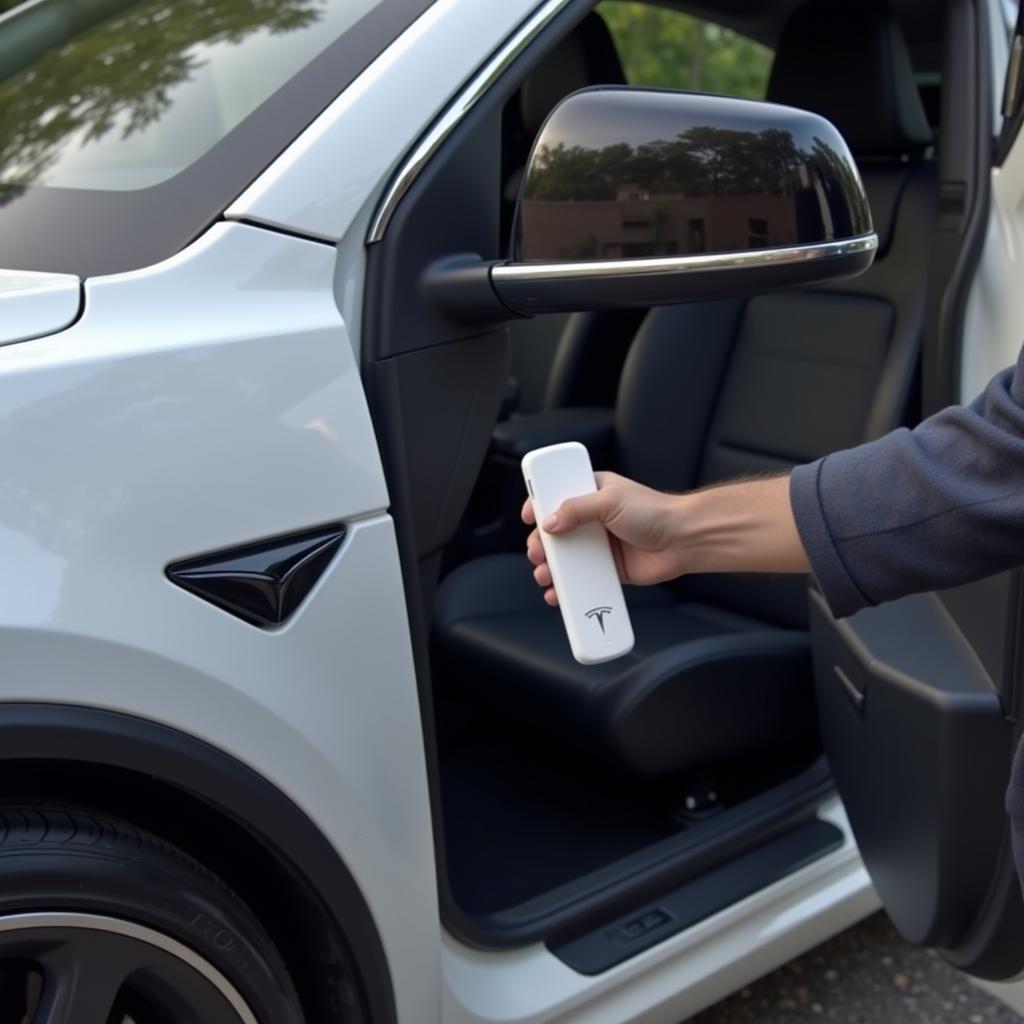A dead tesla key fob battery can leave you stranded. This comprehensive guide covers everything from identifying a low battery to replacing it yourself, ensuring you’re always ready to hit the road. We’ll explore various aspects of Tesla key fob battery maintenance, troubleshooting, and even delve into some advanced tips.
Recognizing a Dying Tesla Key Fob Battery
How do you know your tesla key fob battery is dying? Several tell-tale signs indicate a low battery, and recognizing them early can prevent unexpected lockouts. These include decreased key fob range, inconsistent locking/unlocking, and a dim or non-responsive key fob display.
 Tesla Key Fob Showing Low Battery Indicator
Tesla Key Fob Showing Low Battery Indicator
If you experience any of these symptoms, it’s highly recommended to replace the tesla key fob battery promptly. Ignoring these signs could lead to being locked out of your vehicle. Replacing the battery is a simple process that can save you time, money, and frustration in the long run.
Replacing Your Tesla Key Fob Battery: A Step-by-Step Guide
Replacing a tesla key fob battery is a surprisingly easy DIY task. You’ll need a CR2032 battery, readily available at most stores. A small flathead screwdriver or a similar tool will also be necessary. tesla key fob battery replacement provides detailed instructions, but here’s a quick overview:
- Locate the small notch on the side of the key fob.
- Gently insert the flathead screwdriver into the notch and pry open the key fob casing.
- Carefully remove the old CR2032 battery.
- Insert the new CR2032 battery, ensuring the positive (+) side faces upwards.
- Snap the key fob casing back together.
It’s important to note the correct orientation of the battery. Installing it incorrectly can damage the key fob. Once the new battery is in, test all the key fob functions to ensure it’s working correctly.
Troubleshooting After Battery Replacement
Sometimes, even after a tesla key fob battery replacement, issues might persist. For instance, your tesla model s key fob not working after battery change can be a frustrating experience. This could be due to a variety of reasons, from a faulty new battery to a need for re-synchronization with the vehicle.
Don’t panic! There are several troubleshooting steps you can try. First, double-check the battery installation. Ensure it’s securely in place and oriented correctly. If that doesn’t work, try re-pairing the key fob with your Tesla. The owner’s manual provides instructions specific to your model. You may also consider checking for any software updates for your vehicle, as these can sometimes resolve key fob connectivity issues.
Why Maintaining Your Tesla Key Fob is Important
Regular maintenance, including timely tesla key fob battery replacement, is crucial for a smooth driving experience. A well-maintained key fob ensures seamless access to your vehicle and prevents the inconvenience of being locked out. “Preventive maintenance is key to minimizing unexpected issues,” says John Smith, a leading automotive electronics expert. “A simple battery change can save you from a lot of hassle down the road.”
 Tesla Key Fob and Model Y
Tesla Key Fob and Model Y
Key Fob Alternatives and Future Technologies
Beyond the traditional key fob, Tesla offers alternative access methods, such as the Tesla app and key cards. These options offer added convenience and can serve as backups in case of key fob issues. Explore the model y key fob features and its integration with the Tesla ecosystem.
“The future of car access is evolving rapidly,” notes Sarah Lee, a renowned automotive technology analyst. “We can expect more sophisticated and seamless integration between vehicles and smart devices, moving beyond physical keys.” Considering how remote start functions with other vehicles like how to remote start audi with key fob gives insight into the ongoing evolution. And of course, understanding the overall electrical system of your Tesla, including the tesla dead 12v battery, is crucial for long-term ownership.
In conclusion, understanding your tesla key fob battery and its maintenance is vital for a hassle-free Tesla ownership experience. By following this guide, you can proactively address potential issues and ensure you’re always ready to enjoy the ride.
FAQ
- How often should I replace my Tesla key fob battery? Typically, every 2-3 years, depending on usage.
- What type of battery does the Tesla key fob use? A CR2032 battery.
- Can I drive my Tesla without the key fob? Yes, using the Tesla app or a key card.
- What should I do if my key fob isn’t working after a battery change? Check the battery installation and try re-pairing the key fob.
- Where can I buy a replacement CR2032 battery? Most convenience stores, electronics stores, and online retailers.
- What are the signs of a dying Tesla key fob battery? Decreased range, inconsistent functionality, and a dim display.
- Can a dead key fob battery cause my Tesla to be immobile? It can prevent you from accessing and starting the car conventionally.


